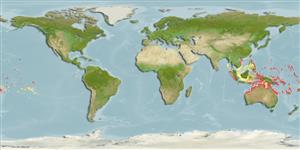Common names from other countries
>
Eupercaria/misc (Various families in series Eupercaria) >
Scaridae (Parrotfishes) > Scarinae
Etymology: Scarus: Greek, skaros = a fish described by anciente writers as a parrot fish; 1601 (Ref. 45335).
More on author: Schultz.
Environment: milieu / climate zone / depth range / distribution range
экология
морской ассоциированный с рифами; пределы глубины 2 - 40 m (Ref. 90102), usually 20 - ? m (Ref. 9710). Tropical; 19°N - 24°S
Western Central Pacific: Philippines to the Solomon Islands, north to the Marshall Islands, south to Scott Reef and the Great Barrier Reef. Recently recorded from Tonga (Ref. 53797).
Size / Вес / Возраст
Maturity: Lm ? range ? - ? cm
Max length : 40.0 cm TL самец/пол неопределен; (Ref. 48636)
Краткое описание
определительные ключи | морфология | морфометрия
колючие лучи спинного плавника (общее число) : 9; членистые (мягкие) лучи спинного плавника (общее число) : 10; колючие лучи анального плавника: 3; членистые (мягкие) лучи анального плавника: 9. Males recognized by the yellow pectoral fins, horizontal green band from tip of snout to above pectoral fin base and large individuals with oval yellow patch on caudal peduncle. Females plain yellowish grey with pale lines along abdominal area (Ref. 48636). Scales large. Median predorsal scales 4; 3 scale rows on cheek, ventral row with 1-2 scales. Truncate caudal fin in initial phase (slightly rounded); slightly lunate in terminal phase. Dental plates nearly covered by lips. Terminal males with 1 or 2 upward-projecting canines posteriorly on lower dental plate and 1 on upper plate. Large initial phase individuals are tan while terminal phase individuals have a distinctive transparent yellowish-tan pectoral fin (Ref. 1602).
Inhabits lagoon and channel reefs, usually deeper 20 m (Ref. 9710). Minimum depth of 2 m reported from Ref. 2689.
Life cycle and mating behavior
Maturities | размножение | Spawnings | Egg(s) | Fecundities | личинки
Oviparous, distinct pairing during breeding (Ref. 205).
Parenti, P. and J.E. Randall, 2000. An annotated checklist of the species of the labroid fish families Labridae and Scaridae. Ichthyol. Bull. J.L.B. Smith Inst. Ichthyol. (68):1-97. (Ref. 35918)
Статус Красного Списка МСОП (Ref. 130435)
CITES (Ref. 128078)
Not Evaluated
Угроза для людей
Harmless
Использование человеком
рыболовство: коммерческий; аквариум: коммерческий
дополнительная информация
инструменты
Специальные отчеты
Скачать в формате XML
ресурсы в Интернет
Estimates based on models
Preferred temperature (Ref.
115969): 25.8 - 28.8, mean 27.4 (based on 28 cells).
Phylogenetic diversity index (Ref.
82804): PD
50 = 0.5000 [Uniqueness, from 0.5 = low to 2.0 = high].
Bayesian length-weight: a=0.02399 (0.01219 - 0.04721), b=3.03 (2.85 - 3.21), in cm Total Length, based on LWR estimates for this species & (Sub)family-body (Ref.
93245).
Trophic level (Ref.
69278): 2.0 ±0.00 se; based on food items.
устойчивость к внешним воздействиям (Ref.
120179): средний (среднего размера), минимальное время удвоения популяции 1.4-4.4 года (Preliminary K or Fecundity.).
Fishing Vulnerability (Ref.
59153): Low to moderate vulnerability (30 of 100).
